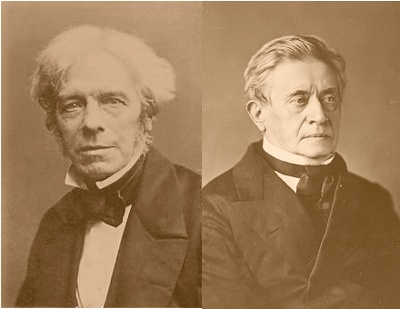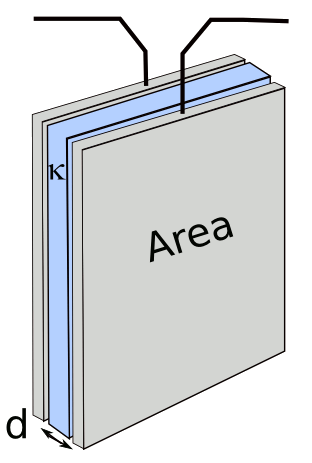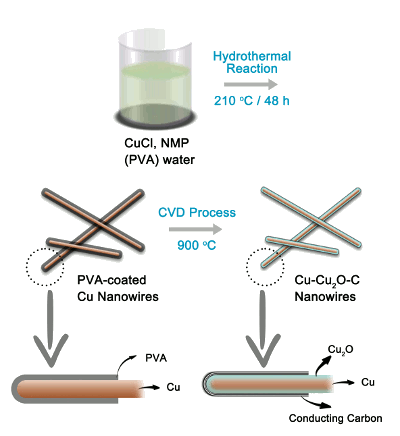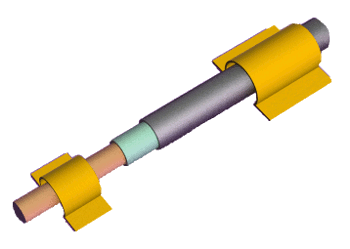Nanocoaxial Capacitors
June 21, 2012
I wrote about the three (perhaps, four) fundamental
electrical components in a
previous article (Memristor Identity Crisis, June 11, 2012). These are the
resistor,
capacitor and
inductor; and, perhaps, the
memristor.
The concept of
resistance goes back to 1827 with the formulation of
Ohm's law. The idea of inductance followed just a few years later with
Michael Faraday's law of induction in 1831. This was independently discovered by
Joseph Henry, but Faraday was the first to publish; so, according to the
rules of the game, Faraday gets the credit.

Michael Faraday, left, circa 1897, and Joseph Henry, right, 1874.
Faraday was the first to publish, but the unit of inductance is known as the Henry.
Source images, left and right, via Wikimedia Commons)
The idea of
electrical capacitance predates these discoveries by nearly a hundred years. The first capacitor, the
Leyden jar was constructed by the
German scientist,
Ewald Georg von Kleist, who lined a
glass jar with
silver foil and found that he could collect
static electrical charge in the device.
The capacitor was independently developed by
Dutch scientists at the
University of Leiden, thus its name ("Leyden" = "Leiden"). It would be interesting to know what these scientists were thinking; after all, they were storing electricity in a jar, just like they would
water.
The simplest capacitor, which can actually be considered as a
conformal mapping of a Leyden jar onto a
plane, is a pair of
parallel plates, as shown in the figure (Drawing rendered by author using
Inkscape).

The capacitance C of a parallel plate capacitor is given by
C = κεoA/d
where κ is the
dielectric constant of the material between the plates, εo is the permittivity of free space (8.854 x 10-12 Farad/meter), A is the plate area, and d is the gap between the plates.
There are a few approximations in this formula, the most significant of which is that the electric field lines are orthogonal to the plates, something that's true for infinite plates, but not for smaller plates.
Smaller plates will have "fringing fields" at the edges, so we can expect nanoscale capacitors to have capacitance that deviates from this simple formula. Also, on the nanoscale, the
molecular structure of the dielectric, which produces the
polarization that multiplies the capacitance, will become important.
One good
experiment is better than a lot of speculation, so a research team led by members of the
Department of Mechanical Engineering & Materials Science of
Rice University (Houston, Texas) has fabricated nanoscale capacitors that have a cylindrical construction much like a miniature version of a Leyden jar.[1-2] It seems that when the object of study becomes smaller, the research team becomes larger. Five other research centers collaborated with Rice on this research project.[3]
The fabrication of such capacitors was an
accidental discovery. The team was looking at
graphene layers on
copper when they found that their process introduced a dielectric layer between the conducting graphene, which served as one capacitor plate, and the internal copper conductor, which served as the other. Said team member
Jun Lou, an associate professor of mechanical engineering and materials science at Rice,
"At the outset, we were just curious to see what would happen electrically and mechanically if we took small copper wires known as interconnects and covered them with a thin layer of carbon... “When people make graphene, they usually want to study the graphene and they aren't very interested in the copper... It's just used a platform for making the graphene."[1]
Their process, as shown in the figure, produced a carbon coating just a few atoms thick on 100
nanometer copper rods. It also had the side-effect of forming a
cuprous oxide ( Cu
2O) dielectric layer between the carbon and the copper.[1]

Process for creation of the Rice University nanoscale coaxial cables, which are used to make nanocapacitors.[1]
Treatment at 900°C converts the PVA to conducting carbon, and it also forms the copper oxide dielectric layer.
(Image: Zheng Liu/Rice University, modified))
The most interesting part of this study is the unexpectedly high capacitance obtained. The capacitance, as measured for a single, coated nanowire (see figure) is about 140 μF-cm
−2, which is an
order of magnitude greater than what one would find by a
classical electrostatic calculation, such as the parallel plate example, above. The conjecture is that the high capacitance is a consequence of
quantum effects at the dielectric–metal interface, made apparent because of the nanoscale dimensions of the device.[1-2]
Lou thinks that parallel arrays of such capacitors could make a useful
energy storage device. [1] I would be worried, however, about the internal resistance of such a capacitor, which would limit its application. This research was funded by the
National Science Foundation, the
Office of Naval Research and the
Welch Foundation, among other organizations.[1] There's a publication in a recent issue of
Nature Communications.[2]

Artist's impression of a nanoscale coaxial cable, mounted as a capacitor.
From the inside, out, there's copper (red), cuprous oxide (green), and carbon (gray).
(Image: Zheng Liu/Rice University))
References:
- Jade Boyd, "'Nanocable' could be big boon for energy storage, Rice University Press Release, June 7, 2012.
- Zheng Liu, Yongjie Zhan, Gang Shi, Simona Moldovan, Mohamed Gharbi, Li Song, Lulu Ma, Wei Gao, Jiaqi Huang, Robert Vajtai, Florian Banhart, Pradeep Sharma, Jun Lou & Pulickel M. Ajayan, "Anomalous high capacitance in a coaxial single nanowire capacitor," Nature Communications, vol. 3, article no. 879 (doi:10.1038/ncomms1833), June 6, 2012.
- Aside from the Rice University participants, this study included members from the Institut de Physique et Chimie des Matériaux, Université de Strasbourg (Strasbourg, France), the Department of Mechanical Engineering, and the Department of Physics, University of Houston (Houston, Texas), the Research Center for Exotic Nanocarbons, Shinshu University (Nagano, Japan), the National Synchrotron Radiation Laboratory, University of Science and Technology of China (Hefei, China), and the Department of Chemical Engineering, Tsinghua University (Beijing, China)
Permanent Link to this article
Linked Keywords: Electronic component; resistor; capacitor; inductor; memristor; resistance; Ohm's law; Michael Faraday; law of induction; Joseph Henry; scientific priority; rules of the game; Henry; Wikimedia Commons; electrical capacitance; Leyden jar; Germany; German; scientist; Ewald Georg von Kleist; glass; jar; silver; static electrical charge; Netherlands; Dutch; University of Leiden; water; conformal map; conformal mapping; plane; parallel; Inkscape; relative permittivity; dielectric constant; permittivity of free space; Farad; meter; electric field; orthogonal; infinity; infinite; nanoscale; molecular structure; polarization; experiment; Department of Mechanical Engineering & Materials Science; Rice University (Houston, Texas); serendipity; accidental discovery; graphene; copper; Jun Lou; nanometer; cuprous oxide; Zheng Liu; order of magnitude; electrostatics; quantum mechanics; energy storage; National Science Foundation; Office of Naval Research; Welch Foundation; Nature Communications.